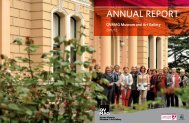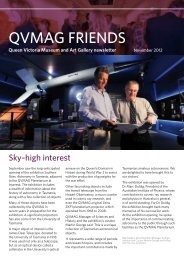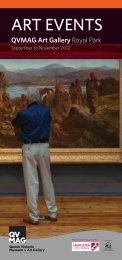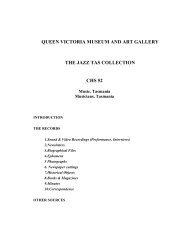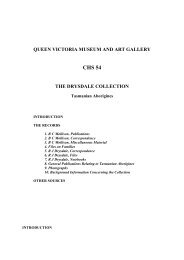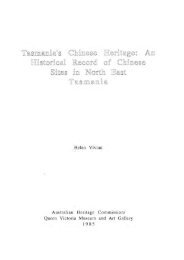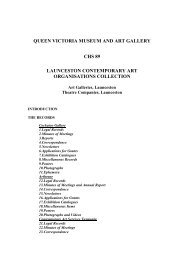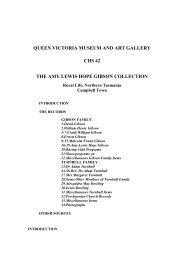On shOw - Queen Victoria Museum and Art Gallery
On shOw - Queen Victoria Museum and Art Gallery
On shOw - Queen Victoria Museum and Art Gallery
Create successful ePaper yourself
Turn your PDF publications into a flip-book with our unique Google optimized e-Paper software.
<strong>On</strong> <strong>shOw</strong><br />
QVMAG <strong>Museum</strong> Inveresk<br />
October 2012 to March 2013
Our two destinations<br />
<strong>Museum</strong> at Inveresk<br />
2 Invermay Road, LAUNCESTON TAS 7248<br />
<strong>Art</strong> <strong>Gallery</strong> at Royal Park<br />
2 Wellington Street, LAUNCESTON TAS 7250<br />
QVMAG is open 10am to 5pm daily. Closed Good<br />
Friday <strong>and</strong> Christmas Day. Admission free.<br />
T 03 6323 3777 w www.qvmag.tas.gov.au<br />
Café<br />
Open 10am to 4pm daily at both sites.<br />
Venue hire<br />
Several spaces are available to hire at both QVMAG<br />
sites. For details, please contact 03 6323 3798.<br />
Our extended family<br />
Why not become a QVMAG Friends’ member today?<br />
You can enjoy a range of special benefits, including<br />
generous discounts, invitations to openings <strong>and</strong> events,<br />
all while adding your support to the QVMAG. Contact<br />
the QVMAG Friends’ office on 03 6323 3706.<br />
This brochure is correct at the time of printing but may be subject<br />
to change. It is printed on Australian made, 100% recycled, FSC®<br />
certified, carbon neutral paper, using vegetable-based inks.<br />
Top QVMAG <strong>Museum</strong> entrance, Inveresk.
Keeping it in the family<br />
The <strong>Queen</strong> <strong>Victoria</strong> <strong>Museum</strong> <strong>and</strong> <strong>Art</strong> <strong>Gallery</strong> (QVMAG)<br />
first opened in 1891 <strong>and</strong> is the largest museum <strong>and</strong><br />
art gallery in Australia located outside a capital city.<br />
Owned <strong>and</strong> operated by the Launceston City Council,<br />
it has two key Launceston sites: the QVMAG <strong>Museum</strong><br />
at Inveresk <strong>and</strong> <strong>Art</strong> <strong>Gallery</strong> at Royal Park.<br />
You’ll find at the <strong>Museum</strong> our extensive Tasmanian<br />
Connections exhibition, which features a number of<br />
significant Tasmanian collection items including Miss<br />
Flinders (featured above), the De Soutter three-seater<br />
monoplane owned <strong>and</strong> flown by Lawrence McKenzie<br />
Johnson, my gr<strong>and</strong>father.<br />
The aircraft has a significant career, starting in 1929<br />
as the first aircraft in Iona Airways of Irel<strong>and</strong>. In<br />
1931 the plane was purchased by two Australians<br />
EH Jenkins <strong>and</strong> JH Jeffery who flew out from the<br />
UK to Australia. Later in 1932 Miss Flinders <strong>and</strong><br />
Lawrence amalgamated with the Holyman brothers<br />
who were also providing an aerial service which<br />
became Tasmanian Aerial Services. This later became<br />
Holyman Airways <strong>and</strong> then ANA <strong>and</strong> eventually<br />
Ansett Airlines of Australia.<br />
Andrew Johnson<br />
Exhibitions Manager, QVMAG<br />
Top Andrew Johnson, Exhibitions Manager.<br />
Cover Tasmanian Connections, QVMAG <strong>Museum</strong>, Inveresk.
The Convict Stain<br />
Vice, Virtue & John West<br />
The exhibition tells the story of how, from small<br />
beginnings in Launceston, a movement grew that<br />
was to change Australia.<br />
Van Diemen’s L<strong>and</strong>, now Tasmania, was first colonised<br />
by Europeans in 1803. It began as a penal colony,<br />
however by 1853 the transportation of convicts<br />
had ended. This change was championed by the<br />
Australasian League, led by Reverend John West.<br />
The Anti-transportation movement was Australia’s<br />
first home-grown movement for union <strong>and</strong> political<br />
independence from Britain.<br />
The exhibition features seldom seen artefacts <strong>and</strong><br />
includes the iconic Banner of the Australasian League.<br />
Designed in Launceston, the banner features the<br />
Southern Cross in its natural formation. The layout<br />
<strong>and</strong> design are the first time the main elements of the<br />
current Australian flag were used together.<br />
when ongoing<br />
where QVMAG, Inveresk<br />
Admission free<br />
Presented by QVMAG<br />
Top Detail of Australasian League flag (background) <strong>and</strong> John West’s Cessation<br />
of Transportation medal.
Tasmanian Connections<br />
A permanent exhibition that features the QVMAG’s<br />
extensive dinosaur collection <strong>and</strong> rocks from northwest<br />
Tasmania dating back 545 million years. Visitors<br />
to Tasmanian Connections will also see artefacts from<br />
Sydney Cove (the first merchant vessel wrecked in<br />
Australian waters), a silver Alfa Romeo sports car,<br />
one of only five like it in the world <strong>and</strong> the skeleton of<br />
the first dolphin ever seen in the upper reaches of the<br />
Tamar River.<br />
Also featured are items from the JW Beattie Collection.<br />
The displays tell the stories of convicts (both male <strong>and</strong><br />
female), the experience of Port <strong>Art</strong>hur, the governors<br />
of Tasmania in the convict era, bushrangers <strong>and</strong> the<br />
early whaling stations. The Launceston City Council<br />
purchased the collection from Beattie in 1927 with the<br />
first Beattie objects on display at the QVMAG in 1928.<br />
MusEuM ExhibiTi<strong>On</strong>s<br />
when ongoing<br />
where QVMAG, Inveresk<br />
Admission free<br />
Presented by QVMAG
Wildlife Photographer of the Year<br />
Wildlife Photographer of the Year is one of the most<br />
prestigious competitions of its kind, attracting entries<br />
from professional <strong>and</strong> amateur photographers of all<br />
ages worldwide. The competition seeks to promote<br />
the discovery, underst<strong>and</strong>ing, responsibility <strong>and</strong><br />
enjoyment of the natural world.<br />
Presented by the Natural History <strong>Museum</strong><br />
in London with BBC Wildlife Magazine <strong>and</strong><br />
the Australian tour is organised by the<br />
Australian <strong>Museum</strong>.<br />
Top left Detail of Tiny warm-up, Cyril Ruoso,Wildlife Photographer of the Year.<br />
Exhibition co-owned by<br />
ANZANG Nature Photography<br />
ANZANG Nature Photography is an annual competition<br />
which encourages photography of nature <strong>and</strong><br />
wilderness in Australia, New Zeal<strong>and</strong>, Antarctica <strong>and</strong><br />
the New Guinea region. Entries are open to local <strong>and</strong><br />
international photographers.<br />
Presented by the South Australian <strong>Museum</strong>.<br />
Top right Detail of Grey-headed Flying<br />
Fox drinking behaviour, Ofer Levy.<br />
ANZANG Nature Photography.<br />
Both showing 15 September to 4 November 2012<br />
at QVMAG, Inveresk. Admission free.
Nurses:<br />
From Zulul<strong>and</strong> to Afghanistan<br />
Australian nurses have been going to war for well<br />
over 100 years but their important contribution to<br />
Australia’s overseas military operations often goes<br />
unreported. The exhibition explores the involvement<br />
of nurses from the first known Australian in the Zulu<br />
War of 1879, right up to the experiences of the male<br />
<strong>and</strong> female nurses serving in recent conflicts <strong>and</strong><br />
peace keeping operations. Using the Memorial’s rich<br />
collection, the exhibition will highlight the personal<br />
stories of Army, Air Force <strong>and</strong> Navy nurses who have<br />
served overseas; their difficulties <strong>and</strong> challenges,<br />
along with their determination to care for the sick <strong>and</strong><br />
wounded, come what may.<br />
MusEuM ExhibiTi<strong>On</strong>s<br />
when 16 February to 19 May 2013<br />
where QVMAG, Inveresk<br />
Admission free<br />
Presented by Australian War Memorial<br />
Top Courtesy of Australian War Memorial 000924.
MusEuM ExhibiTi<strong>On</strong><br />
Southern Skies:<br />
Astronomy in Tasmania<br />
Situated in the QVMAG Planetarium foyer, the<br />
exhibition presents the story of Tasmanian astronomy<br />
<strong>and</strong> features many telescopes <strong>and</strong> other pieces of<br />
equipment (some quite unusual) that have been used<br />
for research in the State.<br />
See a Skylark rocket used by Tasmanians to study<br />
X-rays from space, as well as Tasmania’s largest<br />
amateur-built optical telescope, <strong>and</strong> a telescope that<br />
can’t swing left or right … is it jammed? No, <strong>and</strong> find<br />
out why. Also featured is a machine that detected<br />
muons—particles that live for only a few millionths of<br />
a second—<strong>and</strong> how it showed that Einstein was right.<br />
You can learn the story of a man who built the world’s<br />
largest filled-aperture radio telescope in Tasmania.<br />
Amazing astronomical stories to tell, all within the<br />
Southern Skies: Astronomy in Tasmania exhibition.<br />
when ongoing<br />
where QVMAG, Inveresk<br />
Admission free<br />
Presented by QVMAG<br />
Top Astronomical Society of Tasmania members at an observing site in 1998.<br />
QVMAG acknowledges the<br />
generous sponsorship support of
Let there be dark<br />
The QVMAG Planetarium is where you will see<br />
astronomical concepts demonstrated in ways<br />
that are both dramatic <strong>and</strong> scientifically accurate.<br />
Currently screening are Two Small Pieces of Glass:<br />
The History of the Telescope <strong>and</strong> What Happened to<br />
Pluto? For session times <strong>and</strong> details please visit<br />
www.qvmag.tas.gov.au.<br />
both shows are followed by a live description of<br />
the current night sky over Tasmania using the<br />
Planetarium’s Zeiss star projector.<br />
Two Small Pieces of Glass<br />
2pm Tuesday to Saturday<br />
What Happened to Pluto?<br />
4pm Tuesday to Friday <strong>and</strong> 3pm Saturday<br />
Featured during the January 2013 school holidays is<br />
a new children’s show: The Secret of the Cardboard<br />
Rocket* (image featured above). Children build a<br />
rocket made of cardboard in their garden, <strong>and</strong> their<br />
imagination takes them on a journey in their rocket<br />
through the solar system.<br />
show titles <strong>and</strong> times will vary during the school<br />
holidays. Please visit www.qvmag.tas.gov.au.<br />
An admission fee applies to all Planetarium shows.<br />
Closed sunday, Monday <strong>and</strong> public holidays.<br />
suitable only for ages five <strong>and</strong> up.<br />
*suitable for all ages
Replay>> Sporting Life in Tasmania<br />
An exhibition which explores the historical background<br />
of many sports in Tasmania <strong>and</strong> introduces some of<br />
the characters <strong>and</strong> events contributing to the growth<br />
of each sport. The exhibition uses individual stories<br />
<strong>and</strong> pictorial evidence of Tasmania’s sporting heritage<br />
to rediscover the human side of sport <strong>and</strong> its effect on<br />
communities <strong>and</strong> the qualities of citizenship.<br />
Coming soon to Replay is a new fly-fishing exhibition<br />
which looks at some of the forgotten stories behind<br />
the history of fly-fishing in Northern Tasmania. It<br />
acknowledges the skill of the fly-tier <strong>and</strong> the mystique<br />
of the relationship between the act of fly-fishing <strong>and</strong><br />
the natural l<strong>and</strong>scape of Tasmania.<br />
Transforming the Isl<strong>and</strong><br />
This is the story of how the railways shaped Tasmania,<br />
changing the way we live <strong>and</strong> work. It recounts the<br />
important role played by the Railway Workshops<br />
at Inveresk, which formed the largest integrated<br />
engineering workshop site in the State. The exhibition<br />
features many items, large <strong>and</strong> small, from the<br />
QVMAG’s extensive railway collection.<br />
Top Flybird orange caddis tied by Jan Spencer.
The Blacksmith Shop<br />
The Blacksmith Shop consists of a series of buildings<br />
built between 1909 <strong>and</strong> 1937. Blacksmiths <strong>and</strong> other<br />
tradesmen worked in this area, shaping heated metal<br />
with either h<strong>and</strong> tools or a variety of mechanical<br />
hammers. The items that were produced included<br />
tools, hooks <strong>and</strong> springs.<br />
Here, amidst the array of forges, hammers, furnaces<br />
<strong>and</strong> the earthen floor, it becomes possible to<br />
comprehend the raw energy <strong>and</strong> forces of the<br />
Industrial Revolution. A walkway guides you through<br />
this unique experience with the voices of workers <strong>and</strong><br />
sounds of machinery.<br />
The Blacksmith Shop remained in operation until the<br />
site closed in July 1994.<br />
MusEuM ATTRACTi<strong>On</strong>s<br />
Heritage Trail<br />
Discover the QVMAG Inveresk site through the<br />
Heritage Trail, which is a series of interpretation<br />
panels showing the buildings, previous uses <strong>and</strong><br />
the experiences of men who worked there. Thirtyseven<br />
interpretation points around the site will lead<br />
you to smaller exhibits including the Signal Box, the<br />
Weighbridge, the Railway Institute, the Compressor<br />
<strong>and</strong> Switch Rooms <strong>and</strong> the Signwriters Shop.<br />
Top The Blacksmith Shop, QVMAG <strong>Museum</strong>, Inveresk.
Teach <strong>and</strong> learn<br />
Across our two QVMAG sites, young learners are<br />
encouraged to explore <strong>and</strong> be enthused by our art,<br />
science <strong>and</strong> social history collections. For information<br />
on the activities detailed below please use the<br />
following contacts.<br />
T 03 6323 3798 (Mon to Fri, 8.30am to 4.30pm)<br />
E bookings@qvmag.tas.gov.au<br />
w www.qvmag.tas.gov.au<br />
Advance bookings<br />
Bookings are essential for all school groups <strong>and</strong> are<br />
requested a fortnight in advance to ensure that dates,<br />
times <strong>and</strong> staff can be confirmed.<br />
Serious fun for kids<br />
QVMAG’s Playgroup introduces children aged two to<br />
six years old <strong>and</strong> their carers to the QVMAG <strong>Museum</strong><br />
site with stories, craft <strong>and</strong> educational games.<br />
10 <strong>and</strong> 17 October<br />
Tadpoles <strong>and</strong> Frogs<br />
14 <strong>and</strong> 21 november<br />
Playing Around<br />
For the January to March 2013 themes, please visit<br />
www.qvmag.tas.gov.au in December 2012.
School’s out<br />
QVMAG offers an exciting <strong>and</strong> diverse range of funfilled<br />
learning activities for children aged 5 to 14 years<br />
through its regular School Holiday Program. The next<br />
School Holiday Program runs in January 2013. Please<br />
visit www.qvmag.tas.gov.au from December 2012.<br />
Learning Centre<br />
Free to visiting schools, the <strong>Museum</strong> Learning Centre<br />
is the perfect place to start your visit at the <strong>Museum</strong>.<br />
The layout of the Centre offers versatility of use with a<br />
carpeted floor <strong>and</strong> wet area. The space can be utilised<br />
at the beginning or end of a visit.<br />
Above <strong>and</strong> beyond<br />
Education kits are downloadable for teachers. Topics<br />
include: <strong>Art</strong> <strong>and</strong> Sols; The Great Dying: Extinctions<br />
That Changed Life on Earth; Past Lives, New Beginnings:<br />
Migration <strong>and</strong> Tasmania.<br />
TEACh AnD LEARn<br />
Top Creativity at work during the QVMAG’s regular School Holiday Program.
MusEuM ATTRACTi<strong>On</strong><br />
Phenomenal fun<br />
The QVMAG Inveresk features the Phenomena<br />
Factory, a free-entry interactive science centre<br />
providing h<strong>and</strong>s-on education for kids of all ages.<br />
Challenge yourself in the Perception Tunnel or test<br />
your reactions while you touch, switch, pull <strong>and</strong> crank<br />
your way around the Phenomena Factory, actively<br />
learning about science along the way.<br />
Phenomena Factory exhibits include Death at a Distance,<br />
Dice with Death, Sniff a Snack, <strong>and</strong> Squeeze <strong>and</strong><br />
Serve—all from Questacon, the National Science <strong>and</strong><br />
Technology Centre in Australia. You will also find the<br />
Jaffa Machine donated by Hydro Tasmania which turns<br />
human mechanical energy into kinetic energy. Crank<br />
the h<strong>and</strong>le <strong>and</strong> sustain the energy output long enough<br />
<strong>and</strong> you’ll be rewarded with a jaffa.<br />
The Phenomena Factory was the result of a partnership<br />
between Bell Bay Aluminium <strong>and</strong> the <strong>Queen</strong> <strong>Victoria</strong><br />
<strong>Museum</strong> <strong>and</strong> <strong>Art</strong> <strong>Gallery</strong>. Educational resources are<br />
available to download at www.qvmag.tas.gov.au.<br />
Top Phenomena Factory, QVMAG <strong>Museum</strong>, Inveresk.
<strong>Museum</strong> Shop<br />
The <strong>Museum</strong> Shop is a unique retail destination<br />
featuring Tasmanian products that reflect the style<br />
<strong>and</strong> history of our <strong>Museum</strong> <strong>and</strong> its attractions.<br />
Whether you are looking for something for that<br />
special someone or just travelling through, you’ll<br />
find a wide range of stationery, h<strong>and</strong>crafted jewellery,<br />
posters, gifts <strong>and</strong> toys relating to natural history<br />
<strong>and</strong> science.<br />
The <strong>Museum</strong> shop at inveresk<br />
is open daily from 10am to 5pm.<br />
For more information please call 03 6323 3742<br />
or email shop@qvmag.tas.gov.au.
KINGS<br />
PARK<br />
T A M A R R I V E R<br />
Park St<br />
ROYAL PARK<br />
<strong>Art</strong><br />
<strong>Gallery</strong><br />
S<br />
Bathurst Street<br />
Brisbane<br />
Wellington Street<br />
P<br />
Street<br />
Cameron<br />
Paterson<br />
Cimitiere<br />
Charles<br />
M A L L<br />
Street<br />
Cameron<br />
St John<br />
Street<br />
Street<br />
St<br />
George<br />
Street<br />
Paterson Street West Car Park<br />
P 79–81 Paterson Street, Launceston<br />
Opening hours<br />
Monday to saturday from 9.00am to midnight<br />
sunday from 10.00am to 5.30pm<br />
A parking fee applies<br />
FREE parking from 3.30pm to 5.30pm daily<br />
Secure night parking<br />
$2.00 per entry<br />
Monday to Friday from 5.30pm to 12.30am<br />
saturday from 4.00pm to 12.30am
port<br />
Goderich Street<br />
Lindsay Street<br />
N O R T H E S K R I V E R<br />
William<br />
Esplanade<br />
Invermay Road<br />
Street<br />
Street<br />
P<br />
INVERESK<br />
PRECINCT<br />
amar<br />
Street<br />
CITY<br />
PARK<br />
<strong>Museum</strong><br />
Catch the Tiger<br />
A Launceston City Council Sustainable Transport<br />
Strategy initiative, the FREE Tiger Bus is available<br />
throughout the day to provide easy access to<br />
the QVMAG <strong>Museum</strong> <strong>and</strong> <strong>Art</strong> <strong>Gallery</strong> <strong>and</strong> other<br />
Launceston City Council attractions.<br />
River Explorer<br />
inveresk (<strong>Museum</strong>) to Paterson street (<strong>Art</strong><br />
<strong>Gallery</strong>) operates every hour from the inveresk<br />
stop starting from 10.30am until 3.30pm.<br />
For route information please contact 03 6323 3000.
<strong>On</strong> <strong>shOw</strong><br />
QVMAG <strong>Art</strong> <strong>Gallery</strong> Royal Park<br />
October 2012 to March 2013
Our two destinations<br />
<strong>Art</strong> <strong>Gallery</strong> at Royal Park<br />
2 Wellington Street, LAUNCESTON TAS 7250<br />
(Closest public parking is at Paterson Street West<br />
Car Park, 79–81 Paterson Street, Launceston)<br />
<strong>Museum</strong> at Inveresk<br />
2 Invermay Road, LAUNCESTON TAS 7248<br />
QVMAG is open 10am to 5pm daily. Closed Good<br />
Friday <strong>and</strong> Christmas Day. Admission free.<br />
T 03 6323 3777 w www.qvmag.tas.gov.au<br />
Café<br />
Open 10am to 4pm daily at both sites.<br />
Venue hire<br />
Several spaces are available to hire at both QVMAG<br />
sites. For details, please contact 03 6323 3798.<br />
Public programs<br />
Free Guided tour (30 minutes)<br />
11am <strong>and</strong> 2pm on Sundays.<br />
Guide’s Choice gallery talk (20 minutes)<br />
10.15am third Thursday <strong>and</strong> 2pm third Sunday<br />
of each month.<br />
Curator’s Choice lunchtime talk (20–30 minutes)<br />
1.15pm first <strong>and</strong> third Tuesday of the month.<br />
For more information please call 03 6323 3798.<br />
Top QVMAG <strong>Art</strong> <strong>Gallery</strong>, Royal Park.
A Tasmanian focus<br />
The extent, depth <strong>and</strong> diversity of the QVMAG’s fine<br />
art <strong>and</strong> decorative arts collections, is exceptional for<br />
a regional art museum in Australia. The collections<br />
have continued to develop largely as a result of<br />
donations by members of the Launceston community<br />
for more than 150 years.<br />
Since the formation of the QVMAG <strong>Art</strong>s Foundation in<br />
1985 they, with the support of the Tasmanian Government,<br />
have raised over $1.25 million <strong>and</strong> supported the<br />
acquisition of over 140 artworks. The QVMAG Friends<br />
have also made valued contributions to our collection.<br />
<strong>On</strong>e of the key strengths of the fine art <strong>and</strong> decorative<br />
arts collections is the Tasmanian focus, in particular<br />
northern Tasmania. Our Tasmanian Colonial <strong>Art</strong><br />
collection highlights the artistic heritage of Tasmania<br />
through paintings, works on paper <strong>and</strong> sculpture.<br />
<strong>On</strong>e of the unique aspects is its nationally significant<br />
colonial portraits, l<strong>and</strong>scapes <strong>and</strong> 19th century works<br />
on paper.<br />
We invite you to experience these important collections<br />
on display today, which reflect Launceston’s heritage<br />
<strong>and</strong> creative future.<br />
Richard Mulvaney<br />
Director, <strong>Queen</strong> <strong>Victoria</strong> <strong>Museum</strong> <strong>and</strong> <strong>Art</strong> <strong>Gallery</strong><br />
Top Richard Mulvaney Director, QVMAG.<br />
Cover Robert Dowling (1827–1866) after Franz Xavier Winterhalter (1806-1873)<br />
<strong>Queen</strong> <strong>Victoria</strong>, 1862, London, oil on canvas, commissioned by local subscribers<br />
to the Mechanics’ Institute (Launceston) in 1860, received 1863, transferred to<br />
QVMAG 1891.
...come to life...<br />
... foregrounds the strength <strong>and</strong> diversity of an art<br />
scene today that is generated by Tasmania’s younger<br />
professional artists. It includes a variety of media,<br />
from painting <strong>and</strong> photography, through to interactive<br />
sound <strong>and</strong> video works. The exhibition surveys<br />
how these contemporary artists continue to use<br />
human subjectivity to explore a diversity of ideas in<br />
contemporary life.<br />
Many of the artists in this show are central to, or are<br />
often present within, their works. The artists respond<br />
to individual experiences, emotions <strong>and</strong> the situations<br />
they construct in order to generate the artworks.<br />
Various strategies, processes <strong>and</strong> technologies have<br />
often required these artists to become part of the<br />
actual work. Some works use traditional forms such as<br />
narrative to communicate ideas, while others respond<br />
to international trends in contemporary culture.<br />
ART GALLERy ExhibiTi<strong>On</strong>s<br />
when until 17 February 2013<br />
where <strong>Gallery</strong> 3, QVMAG, Royal Park<br />
Admission free<br />
Presented by QVMAG <strong>and</strong> CAST<br />
Top Lydia Evangelou-Oost, Soliloquy, 2011, Installation documentation—still.
Looking at L<strong>and</strong>scape<br />
An exhibition of Glover Prize Winners<br />
The Glover Prize celebrates the contribution that<br />
colonial artist John Glover (1767–1849) made to<br />
Australian art.<br />
After a successful career in Engl<strong>and</strong>, Glover arrived<br />
in Van Diemen’s L<strong>and</strong> in 1831 at the age of 64.<br />
He settled south of Ev<strong>and</strong>ale, painting the<br />
Aboriginal people as he imagined them before their<br />
dispossession <strong>and</strong> capturing the intense light <strong>and</strong><br />
strange vegetation he encountered.<br />
The Glover Prize encourages artists to channel<br />
Glover’s capacity to face new challenges. It is<br />
awarded for a work judged the best contemporary<br />
l<strong>and</strong>scape painting of Tasmania. The aim is to<br />
stimulate conversations about the infinite meanings<br />
<strong>and</strong> possibilities expressed in the words ‘l<strong>and</strong>scape’,<br />
‘painting’ <strong>and</strong> ‘Tasmania’.<br />
when 9 February to 24 March 2013<br />
where <strong>Gallery</strong> 2, QVMAG, Royal Park<br />
Admission free<br />
Presented by QVMAG <strong>and</strong> The John Glover Society
Into the Wild<br />
Wilderness Photography in Tasmania<br />
Highlighting the artistic talent of key Tasmanian<br />
wilderness photographers <strong>and</strong> the impact that this<br />
type of photography has had on Tasmania, Into the<br />
Wild is a photographic exhibition which charts the<br />
development of wilderness photography from its<br />
earliest days to the present.<br />
Key themes include: In the beginning; A growing<br />
awareness; You don’t know what you’ve got till it’s gone;<br />
<strong>and</strong> The future.<br />
Featured photographers include Morton Allport,<br />
Stephen Spurling III, John Watt Beattie, HJ King,<br />
Florence <strong>and</strong> George Perrin, RE Smith, Frederick<br />
Smithies, Frank Styant Browne, Jack Thwaites,<br />
Frank Bolt, Olegas Truchanas, Peter Dombrovskis,<br />
Jim Engl<strong>and</strong>, Rob Blakers, David Stephenson <strong>and</strong><br />
Martin Walch.<br />
when 16 March 2013 to 16 February 2014<br />
where <strong>Gallery</strong> 3, QVMAG, Royal Park<br />
Admission free<br />
Presented by QVMAG<br />
Top Photographer: Olegas Truchanas. QVMAG collection, reproduced with the<br />
permission of Melva Truchanas.
<strong>Art</strong>Rage<br />
Selected works from 2012<br />
Now in its 18th year, <strong>Art</strong>Rage is an annual initiative<br />
of the QVMAG which draws on folios of work of<br />
Tasmanian Certificate of Education students.<br />
A diverse, vibrant <strong>and</strong> often provocative exhibition<br />
which offers insight into some of the pressing issues<br />
currently facing young people today, <strong>Art</strong>Rage is also<br />
a unique opportunity to view an ambitious <strong>and</strong> multidisciplinary<br />
student exhibition with a huge range of<br />
materials <strong>and</strong> media employed.<br />
ART GALLERy ExhibiTi<strong>On</strong>s<br />
when 15 December 2012 to 2 April 2013<br />
where <strong>Gallery</strong> 4, QVMAG, Royal Park<br />
Admission free<br />
Presented by QVMAG<br />
Top <strong>and</strong> below <strong>Art</strong>Rage – Selected works from 2011.
A Significant Gift<br />
The collection of Professor Wong Shiu Hon<br />
<strong>and</strong> Mrs Nancy Wong<br />
Professor Wong Shiu Hon <strong>and</strong> Mrs Nancy Wong<br />
have generously gifted a collection of 40 Chinese<br />
ceramics, glass <strong>and</strong> wooden antiquities to the<br />
QVMAG. Their collection, acquired over 35 years,<br />
has been developed to represent the development of<br />
Chinese culture from the earliest Neolithic pottery to<br />
outst<strong>and</strong>ing works from the earlier 20th century.<br />
Formerly Professor of Chinese Studies at the<br />
University of Hong Kong <strong>and</strong> a lecturer at Curtin<br />
University in Western Australia <strong>and</strong> an acclaimed<br />
artist himself, Professor Wong Shiu Hon <strong>and</strong> Mrs<br />
Nancy Wong, previously a senior librarian, now reside<br />
in Hobart. Over the last few years they have donated<br />
a major collection of Chinese objects <strong>and</strong> antiquities<br />
to the Tasmanian <strong>Museum</strong> <strong>and</strong> <strong>Art</strong> <strong>Gallery</strong> <strong>and</strong> looked<br />
to provide a similar opportunity for audiences visiting<br />
the QVMAG to engage with Chinese works of art.<br />
where <strong>Gallery</strong> 5, QVMAG, Royal Park<br />
Admission free<br />
Presented by QVMAG<br />
Top left<br />
Unknown maker, China<br />
Camel<br />
Tang Dynasty (618–907 CE)<br />
earthenware, sancai glaze.<br />
Donated by Professor Wong Shiu Hon<br />
<strong>and</strong> Mrs Nancy Wong.<br />
Top right<br />
Unknown maker<br />
Lokapala (Heavenly Guardian)<br />
Tang Dynasty (618–907 CE)<br />
earthenware, pigments<br />
Donated by Professor Wong Shiu Hon<br />
<strong>and</strong> Mrs Nancy Wong.
A Distinctive Colour<br />
Blue <strong>and</strong> white pottery has been produced for over<br />
a thous<strong>and</strong> years. The development of blue <strong>and</strong><br />
white ceramics is the result of cultural interchange<br />
<strong>and</strong> influence through trade <strong>and</strong> technical progress<br />
through the development of innovative glazing <strong>and</strong><br />
decorating techniques.<br />
Highly sought after by both past <strong>and</strong> present<br />
collectors, exceptional examples have been treasured<br />
for their rarity <strong>and</strong> the skill of the maker <strong>and</strong><br />
decorator. They have also been mass-produced for<br />
world markets.<br />
Ceramic artists today build on the history <strong>and</strong><br />
techniques to create their unique expression <strong>and</strong><br />
interpretation of blue <strong>and</strong> white.<br />
ART GALLERy ExhibiTi<strong>On</strong>s<br />
where <strong>Gallery</strong> 6, QVMAG, Royal Park<br />
Admission free<br />
Presented by QVMAG<br />
Top <strong>and</strong> below Detail of Stephen Bowers, Caucus Race Cup <strong>and</strong> Saucer, 2009,<br />
purchased through funds from the Turner Ralph Foundation, 2010, reproduced by<br />
permission of the artist, <strong>Gallery</strong> 6, QVMAG <strong>Art</strong> <strong>Gallery</strong>, Royal Park.
A Creative Century<br />
The earliest attempts at producing decorative arts<br />
objects in Tasmania were with furniture, followed<br />
by pottery. Prevailing furniture styles, produced<br />
with Tasmania’s unique timbers, remained an<br />
interpretation of British <strong>and</strong> European trends. The<br />
earliest potteries produced simple domestic wares to<br />
satisfy domestic <strong>and</strong> utilitarian needs.<br />
Textiles, particularly embroideries, are one of the<br />
strengths of 19th century Tasmanian decorative arts.<br />
The influence of natural forms, particularly plants,<br />
on the design of textiles <strong>and</strong> decorated furniture,<br />
continued from the 1850s. The establishment of the<br />
<strong>Art</strong>s <strong>and</strong> Crafts Society of Tasmania in 1903, the<br />
first in Australia, encouraged the development of a<br />
distinctive regional style in decorative arts <strong>and</strong> design<br />
in Tasmania.<br />
where <strong>Gallery</strong> 7, QVMAG, Royal Park<br />
Admission free<br />
Presented by QVMAG<br />
Top Amelia Burrows (1860–1927) (attributed), detail of Untitled, Wattle Work<br />
Embroidery, 1890s, Launceston, velvet, various threads, <strong>Gallery</strong> 7, QVMAG <strong>Art</strong><br />
<strong>Gallery</strong>, Royal Park.
Bea Maddock Paintings<br />
1956–1968<br />
An exhibition of 28 paintings by Launceston artist<br />
Bea Maddock. The exhibition includes l<strong>and</strong>scapes,<br />
figure studies, portraits, paintings with religious<br />
subjects <strong>and</strong> abstracts.<br />
Bea Maddock is known <strong>and</strong> respected as an<br />
innovative <strong>and</strong> technically accomplished printmaker.<br />
The exhibition provides a wonderful opportunity to<br />
view Bea’s early paintings, many of which have not<br />
been on public display for years. The vast majority of<br />
the paintings were donated to the QVMAG by<br />
the artist.<br />
ART GALLERy ExhibiTi<strong>On</strong>s<br />
where <strong>Gallery</strong> 8, QVMAG, Royal Park<br />
Admission free<br />
Presented by QVMAG<br />
Top <strong>and</strong> below Bea Maddock Paintings 1956–1968, <strong>Gallery</strong> 8, QVMAG <strong>Art</strong> <strong>Gallery</strong>,<br />
Royal Park.
A Portrait of<br />
Colonial Tasmania<br />
During the 19th century Van Diemen’s L<strong>and</strong> (renamed<br />
Tasmania in 1855) witnessed a flowering of artistic<br />
endeavour that was unsurpassed in the Australian<br />
colonies, as a result of free emigration <strong>and</strong> convict<br />
transportation. In the period before the ready use of<br />
photography, artists, convict <strong>and</strong> free, recorded the<br />
traditional inhabitants, the l<strong>and</strong>, <strong>and</strong> white settlement.<br />
Drawing on rich European traditions of portraiture<br />
<strong>and</strong> l<strong>and</strong>scape painting, the life of the colony was<br />
recorded through visual images.<br />
The later period saw the displacement of the<br />
Aboriginal people, the end of convict transportation,<br />
the growth of settlement, an emerging awareness<br />
of the hinterl<strong>and</strong>, <strong>and</strong> the mantle passed to a fresh<br />
generation of artists <strong>and</strong> subjects. The exhibition<br />
seeks to record these events as seen through the eyes<br />
<strong>and</strong> talents of the artists.<br />
The exhibition also features early examples of<br />
Tasmanian furniture including a rare six-leg casuarina<br />
dresser <strong>and</strong> blackwood bow-fronted sideboard made<br />
in about 1820.<br />
where <strong>Gallery</strong> 9, QVMAG, Royal Park<br />
Admission free<br />
Presented by QVMAG<br />
Top <strong>Gallery</strong> 9, QVMAG <strong>Art</strong> <strong>Gallery</strong>, Royal Park.
Tasmania <strong>and</strong> Beyond<br />
1870–1931<br />
The second half of the 19th century saw the advent<br />
of industrialisation <strong>and</strong> the movement towards<br />
Federation. There was a changed awareness of the<br />
Tasmanian l<strong>and</strong>scape <strong>and</strong> artists were reacting to<br />
events <strong>and</strong> concerns that were to shape the new<br />
century. Of significance was the work of William<br />
Charles Piguenit, Tasmania’s ‘first born artist’.<br />
His atmospheric paintings of place <strong>and</strong> dramatic<br />
depiction of skies <strong>and</strong> precipitous mountains drew a<br />
new public awareness of the beauty <strong>and</strong> mystery of<br />
the Tasmanian l<strong>and</strong>scape.<br />
Also featured in this gallery are works by Hugh Ramsay<br />
<strong>and</strong> Tom Roberts who each had family connections in<br />
northern Tasmania; <strong>and</strong> their colleague George Lambert.<br />
In the latter 19th <strong>and</strong> early 20th centuries Australian<br />
craftspeople <strong>and</strong> designers were part of international<br />
movements of decorative arts styles. The natural<br />
environment was a significant influence, with motifs <strong>and</strong><br />
designs inspired by Australian plants <strong>and</strong> animals being<br />
widely used. Examples can be found within this gallery.<br />
ART GALLERy ExhibiTi<strong>On</strong>s<br />
where <strong>Gallery</strong> 10, QVMAG, Royal Park<br />
Admission free<br />
Presented by QVMAG<br />
Top <strong>Gallery</strong> 10, QVMAG <strong>Art</strong> <strong>Gallery</strong>, Royal Park.
TEACh AnD LEARn<br />
<strong>Art</strong>Sparks! Family <strong>Art</strong> Space<br />
Designed to appeal to young visitors, the space<br />
offers drawing materials <strong>and</strong> child-friendly activity<br />
panels that encourage observation <strong>and</strong> discussion<br />
to help explore art through creative play. Changing<br />
exhibitions include reproductions of art from the<br />
QVMAG collections as well as work produced by<br />
young visitors to Royal Park.<br />
Portraits of You, Portraits of Me<br />
The current featured activity exhibition explores<br />
the functions <strong>and</strong> methods of portraiture <strong>and</strong> selfportraiture.<br />
Set up a pose <strong>and</strong> draw a portrait using<br />
the chairs, props <strong>and</strong> hats provided, or use the mirrors<br />
to draw a self-portrait. Take your work home or add it<br />
to our Children’s <strong>Gallery</strong>.<br />
<strong>Art</strong>Start<br />
You will find the latest <strong>Art</strong>Start exhibition within the<br />
<strong>Art</strong> <strong>Gallery</strong> café. The exhibition features artworks by<br />
primary school students <strong>and</strong> home-educated children<br />
from Northern Tasmania in Kindergarten to Grade 6.<br />
For more information please visit the Education pages<br />
at www.qvmag.tas.gov.au.<br />
Top <strong>Art</strong>Sparks! Family <strong>Art</strong> Space, QVMAG <strong>Art</strong> <strong>Gallery</strong>, Royal Park.
<strong>Gallery</strong> Shop<br />
Our <strong>Gallery</strong> Shop is an exciting retail destination<br />
featuring Tasmanian products that reflect the style<br />
<strong>and</strong> history of the <strong>Art</strong> <strong>Gallery</strong> <strong>and</strong> our collections.<br />
Whether you are travelling through or looking for<br />
something for that special someone, you’ll find a<br />
selection of art <strong>and</strong> design publications, exhibition<br />
catalogues, gifts <strong>and</strong> children’s merch<strong>and</strong>ise.<br />
The <strong>Gallery</strong> shop at Royal Park is<br />
open daily from 10am to 5pm.<br />
For more information please call 03 6323 3742<br />
(<strong>Museum</strong> Shop) or email shop@qvmag.tas.gov.au.



